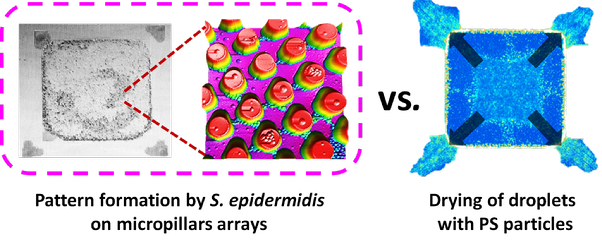A new paper in collaboration with Physics of Fluids and The Hub for Antimicrobials Surfaces from University of Liverpool has been accepted in Langmuir.
The work is focused on the evaporation of water droplets containing Staphylococcus epidermidis (S. epidermidis). This research provides new insights into design criteria for the development of microstructured surfaces on which bacterial propagation can be controlled, limiting the use of bacterial biocides.

Abstract:
We evaluate the effect of epoxy surface structuring on the evaporation of water droplets containing Staphylococcus epidermidis (S. epidermidis). During evaporation, droplets with S. epidermidis cells yield to complex wetting patterns such as the zipping-wetting and coffee-stain effects. Depending on the height of the microstructure, the wetting fronts propagate circularly or in a stepwise manner, leading to the formation of octagonal or square-shaped deposition patterns. We observed that the shape of the dried droplets has considerable influence on the local spatial distribution of S. epidermidis deposited between micropillars. These changes are attributed to an unexplored interplay between the zipping-wetting and the coffee-stain effects in polygonally-shaped droplets containing S. epidermidis. Induced capillary flows during evaporation of S. epidermidis are modeled with polystyrene particles. Bacterial viability measurements for S. epidermidis shows high viability of planktonic cells, but low biomass deposition on the microstructured surfaces. DOI: 10.1021/acs.langmuir.6b01658





